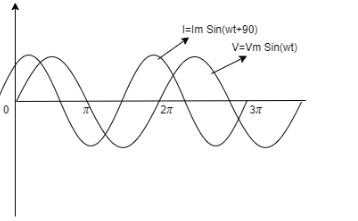Question
Question: An AC source generating a voltage \[V = {V_m}\sin (\omega t)\] is connected to a capacitor of capaci...
An AC source generating a voltage V=Vmsin(ωt) is connected to a capacitor of capacitance C. Find the expression of the current i flowing through it. Plot a graph of V and i versus ωt to show that the current is π/2 ahead of the voltage.
Solution
Understand the concept of current as flow rate of charge per unit time. Also use the formula for voltage passing through a capacitor of capacitance C to deduce the expression. Draw the plot for different values of ω.
Complete answer:
We know that there is an AC source generating a voltage of V=Vmsin(ωt), that is attached to a capacitor of capacitance C.
Now, we know that the voltage passing through the capacitor V is equal to V=Q/C, where Q is the charge value in coulombs and C is capacitance value in farads.
Now, current I in any circuit is defined as the flow rate of charges per unit time. Mathematically,
i=dtdQ
Now, rearranging the Voltage inside a capacitor equation we get,
V×C=Q
Substituting this in the current equation we get,
i=dtd[V×C]
Now, V is given as Vmsin(ωt)for the given circuit, substituting that in the above equation we geti=dtd[C×Vmsin(ωt)]
Applying differentiation inside, we get,
i=C×dtd[Vm]×ωcos(ωt)
Note: Differentiation of sin(ωt)is cos(ωt)multiplied by differentiation of ωt, which is ω.
Now, cos(ωt)can also be written as sin(ωt+π/2), due to quadrants.
i=C×dtd[Vm]×ω×sin(ωt+π/2)
Taking constant term C andωto the denominator,
i=1/C×ωdtd[Vm]×sin(ωt+π/2)
Now, we know that the instantaneous current passing through a capacitor of capacitance C is given as ,
im=C×dtd[Vm]
Applying this concept to the above equation,
⇒i=imsin(ωt+π/2)
Where im=1/CωVm
The term 1/Cω is called capacitive reactance and is represented as Xc.
Now, plot the graph for different values of ωt ranging from zero to360∘.
The resulting graph will see that the current is leading by a phase difference of π/2.

Thus the expression is derived and the graph is drawn accordingly.
Note:
Capacitive reactance is defined as the total opposition to the current flow offered by a capacitor of capacitance C. It is similar to resistance but it’s not equal to resistance. It is represented by the termXc.
